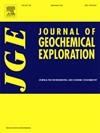Mineral prediction research using the Geology-based Cyclic Adversarial Network for Anomaly Detection
IF 3.3
2区 地球科学
Q1 GEOCHEMISTRY & GEOPHYSICS
引用次数: 0
Abstract
Deep learning algorithms represented by generative adversarial networks (GANs) have been extensively applied in mineral prospectivity mapping research. However, the inherent instability and “black-box” nature of these models have constrained further advancement in such studies. This research proposes an anomaly detection model integrating geochemical data with geological knowledge (Geology-based Cyclic Adversarial Network for Anomaly Detection, G-CANomaly). First, taking the Mila Mountain area of Tibet as the study area, we quantified the relationship between deposit density and ore-controlling factors (fault structures) using multifractal singularity theory. Second, we restructured the network architecture of traditional GANomaly models and embedded geological knowledge to establish the G-CANomaly anomaly detection model, achieving a transition from purely data-driven approaches to hybrid “data + knowledge”-driven methodologies. Finally, we conducted comparative analyses of model performance among GANomaly, CANomaly, and G-CANomaly. The results demonstrate that: (1) The anomaly zones delineated by G-CANomaly exhibit the highest spatial correlation with known mineral occurrences in the study area. (2) The top 3 % anomaly areas can encompass 80 % of known mineral deposits. (3) The main assessment metrics of G-CANomaly, AUC, Accuracy, and Recall, were 0.97, 0.89, and 0.93, showing 3–6 % improvements over baseline models. These findings indicate that the G-CANomaly model demonstrates strong feasibility in geochemical anomaly identification research, with notably enhanced training stability and convergence rate. This study provides valuable references for constructing hybrid geochemical-geological knowledge-driven deep learning models and enriches the methodological framework of mineral prospectivity mapping.
基于地质的循环对抗网络异常检测矿产预测研究
以生成对抗网络(GANs)为代表的深度学习算法在矿产远景图研究中得到了广泛的应用。然而,这些模型固有的不稳定性和“黑箱”性质限制了这类研究的进一步发展。本研究提出了一种将地球化学数据与地质知识相结合的异常检测模型(基于地质的异常检测循环对抗网络,G-CANomaly)。首先,以西藏米拉山地区为研究区,利用多重分形奇异性理论量化了矿床密度与控矿因素(断裂构造)的关系。其次,重构传统GANomaly模型和嵌入地质知识的网络架构,建立G-CANomaly异常检测模型,实现了从单纯数据驱动向“数据+知识”混合驱动的转变。最后,我们对GANomaly、CANomaly和G-CANomaly的模型性能进行了比较分析。结果表明:(1)g - cannormal圈定的异常带与研究区已知矿位的空间相关性最高。(2)前3%的异常区可覆盖80%的已知矿床。(3) g - cannormy的主要评估指标AUC、准确率和召回率分别为0.97、0.89和0.93,比基线模型提高了3 - 6%。这些结果表明,G-CANomaly模型在地球化学异常识别研究中具有较强的可行性,训练稳定性和收敛速度显著提高。该研究为构建地球化学-地质知识驱动的混合深度学习模型提供了有价值的参考,丰富了找矿理图的方法框架。
本文章由计算机程序翻译,如有差异,请以英文原文为准。
求助全文
约1分钟内获得全文
求助全文
来源期刊

Journal of Geochemical Exploration
地学-地球化学与地球物理
CiteScore
7.40
自引率
7.70%
发文量
148
审稿时长
8.1 months
期刊介绍:
Journal of Geochemical Exploration is mostly dedicated to publication of original studies in exploration and environmental geochemistry and related topics.
Contributions considered of prevalent interest for the journal include researches based on the application of innovative methods to:
define the genesis and the evolution of mineral deposits including transfer of elements in large-scale mineralized areas.
analyze complex systems at the boundaries between bio-geochemistry, metal transport and mineral accumulation.
evaluate effects of historical mining activities on the surface environment.
trace pollutant sources and define their fate and transport models in the near-surface and surface environments involving solid, fluid and aerial matrices.
assess and quantify natural and technogenic radioactivity in the environment.
determine geochemical anomalies and set baseline reference values using compositional data analysis, multivariate statistics and geo-spatial analysis.
assess the impacts of anthropogenic contamination on ecosystems and human health at local and regional scale to prioritize and classify risks through deterministic and stochastic approaches.
Papers dedicated to the presentation of newly developed methods in analytical geochemistry to be applied in the field or in laboratory are also within the topics of interest for the journal.
 求助内容:
求助内容: 应助结果提醒方式:
应助结果提醒方式:


